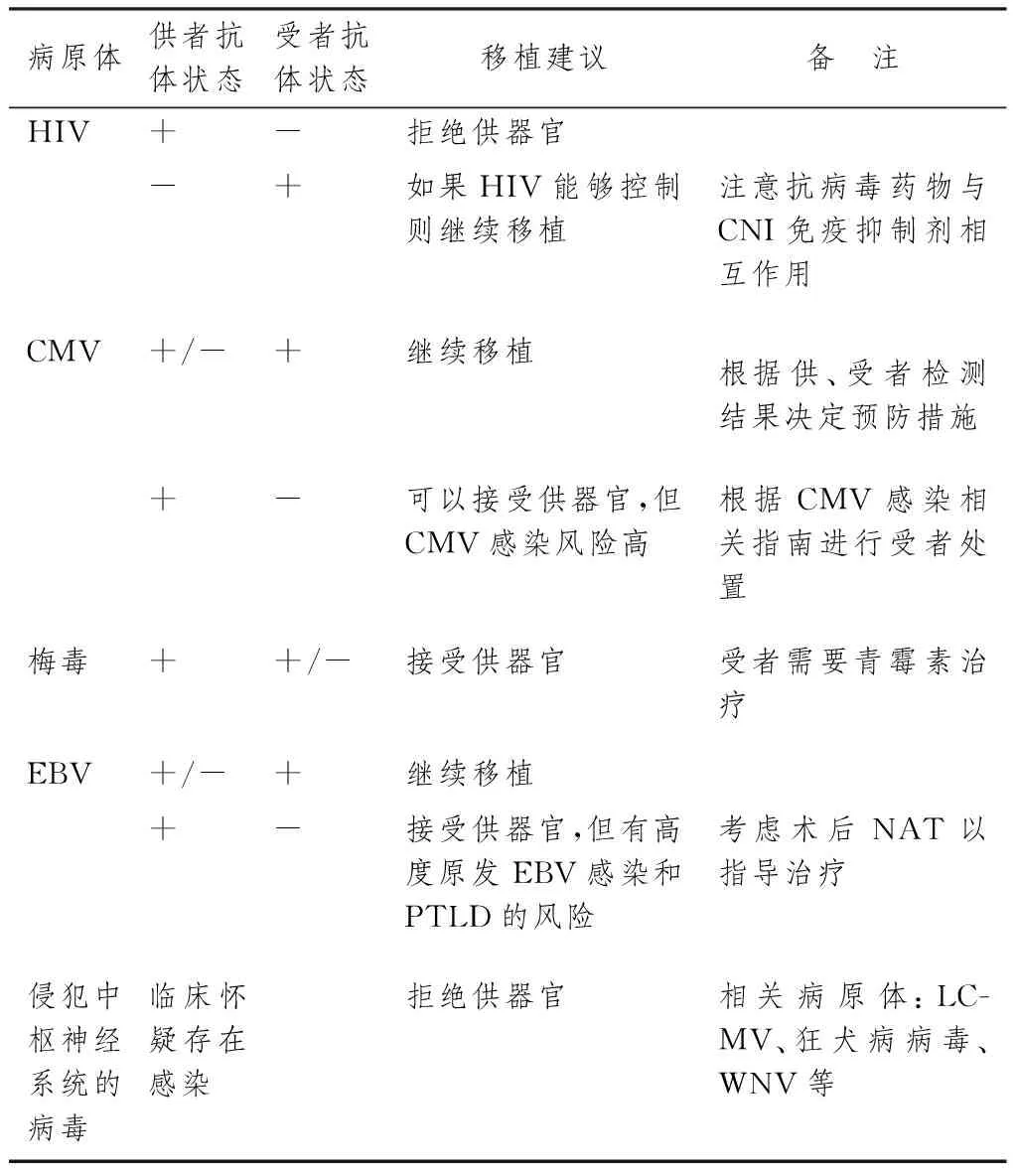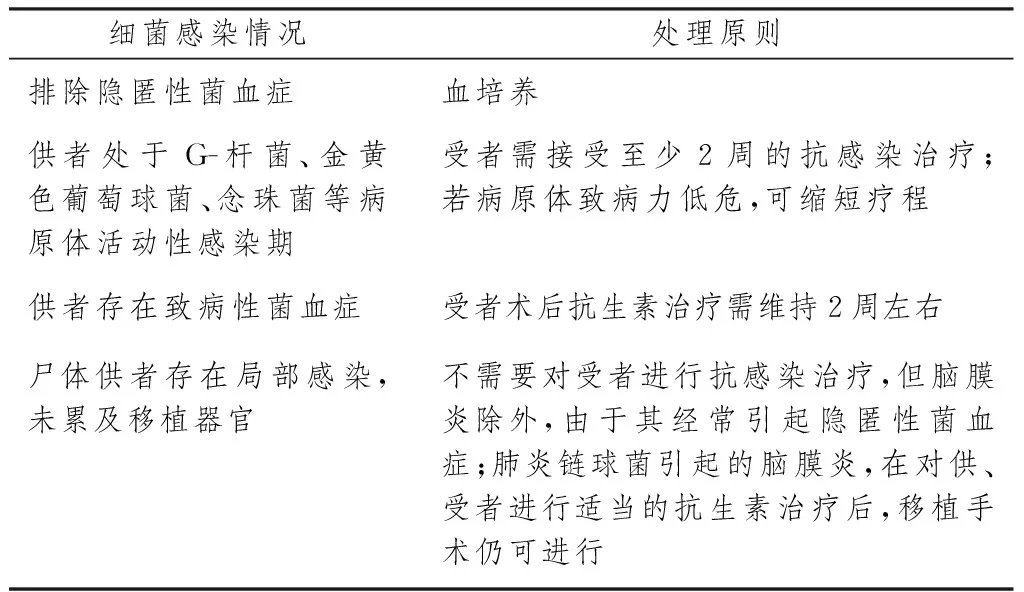公民逝世后器官捐献感染性供者的移植应用
2016-04-19王长希邓荣海
王长希 邓荣海
·专家论坛·
公民逝世后器官捐献感染性供者的移植应用
王长希1, 2邓荣海1

王长希,教授,主任医师,博士生导师。现任中山大学附属第一医院器官移植科主任。学术兼职包括:中国医师协会器官移植医师分会肾移植专业委员会副主任委员,中国研究型医院学会移植医学专业委员会常委,中华医学会泌尿外科学分会肾移植学组委员,广东省器官移植学会常委,国际移植学会委员等。《International Journal of Clinical Practice (China)》、《中华医学杂志(英文版)》、《中华器官移植杂志》、《中华移植杂志(电子版)》、《国际移植与血液净化杂志》、《器官移植》、《世界临床药物》等期刊编委。从事肾移植临床20余年,参与完成肾移植2 000余例,其中主刀800余例。发表中英文论著逾200篇,其中SCI论文30余篇,主编或参编《临床肾移植学》等论著6部,获国家发明专利1项。主持国家、省部级基金项目10余项,研究经费近1 000万元,荣获2013年全国泌尿外科年会“扁鹊奖”。
实体器官移植后感染是影响移植器官及受者存活的重要因素。我国自开展公民逝世后器官捐献移植以来,供者来源性感染(DTI)案例不断增加。DTI包括各种细菌、真菌、病毒等。临床上需要根据具体的病原体及受者的情况综合判断感染性供者器官是否使用。受者术后是否会发生DTI受供者感染的病原体种类、受者情况、术中情况及免疫抑制剂的应用方案等多种因素的影响。我国应建立完善供者来源性疾病的监控/报告系统,更好地通过循证医学证据指导临床。
器官捐献; 器官移植; 供者来源性感染
实体器官移植后感染是导致受者死亡的重要原因[1],也是术后1年内受者死亡的首位因素,占30.9%[2]。许多感染性疾病可通过供者传播给移植受者,称之为供者来源性感染(donor-transmitted infections,DTI)。据统计,所有实体器官移植DTI发生率约为0.2%~1.7%[3-4]。为更好地监控DTI,美国于2005年成立了疾病传播咨询委员会(Disease Transmission Advisory Committee,DTAC),收集美国各移植中心及人体器官获取组织(Organ Procurement Organization,OPO)报告的DTI,形成DTI数据库,目的在于帮助美国器官获取和登记网络/器官资源共享网络(OPTN/UNOS)识别、确认潜在的DTI供者[5-7]。
我国自开展公民逝世后器官捐献移植以来,DTI案例不断增加,已成为当前讨论热点之一。对待DTI需严肃谨慎,否则可能导致严重后果,如2011年中国台湾艾滋病供者器官移植事件将DTI推上了社会舆论的风口浪尖。因此,在器官获取前甄别可能导致DTI的潜在供者十分重要[8]。潜在供者发生感染时,器官移植相关从业人员常面临两难选择:一方面,供者器官来之不易,应最大限度减少潜在供者器官的浪费;另一方面,使用感染性供者器官需最大程度保证移植受者获益。当不能确定合并感染的潜在供者是否一定导致DTI时,这种处境更加突出。本文就感染性潜在供者的移植应用评估以及移植后受者管理等方面提出一些建议,以供参考。
1 DTI类型
细菌、分枝杆菌、病毒、真菌和寄生虫等多种病原体均被证实可以通过实体器官移植由供者传播给受者[9-10],其中以病毒、细菌最为常见。尽管真菌感染发生率不高,但是后果最为严重。根据供者感染存在的形式,可以分为:(1)供者的活动性感染或潜伏感染,在捐献时即存在的感染,包括供者捐献前血培养、引流液培养、痰培养、导管培养、尿培养等阳性,或者潜伏感染处于窗口期,常规实验室检查为阴性者;(2)供者体内的病原体定植,如病原体在呼吸道、血管或其他器官的定植,其中最常见的为ICU中定植的鲍曼不动杆菌等。
2 感染性供者器官的评估应用
2.1 病毒感染
能够通过供者器官捐献移植传播的病毒感染包括HBV、HCV、HIV、疱疹病毒、腺病毒、流感病毒、淋巴细胞性脉络丛脑膜炎病毒(lymphaticchoriomeningitis virus,LCMV)、人类副流感病毒-3、细小病毒B19、狂犬病病毒、西尼罗河病毒(West Nile virus,WNV)等[11-15]。如遇以上病毒阳性的供者器官,需谨慎考虑。由于时间和各种条件的限制,通常无法对供者进行全面、彻底的病毒感染筛查。在这种情况下,在感染HIV、HCV等病原体后至产生抗体之前,如果按常规的检查抗体的方法是无法检测出阳性结果[16],因而会在此窗口期因假阴性而导致疾病的传播。
2.1.1 HCV阳性供者
如果受者HCV阳性,则可以进行捐献移植,但是应该注意检测基因型。HCV主要分为6个基因型(用数字1~6表示)和50个亚型(用英文字母表示),我国常见的为1b和2a型,其中以1b为主,6型主要见于中国香港和澳门。不同的HCV基因型治疗方案不同,因此需要注意供、受者间的基因型是否相同,从而决定是否进行捐献移植或者决定治疗方案。如果受者HCV阴性,除非在急诊且受者知情同意的情况下,否则不可进行捐献移植。
2.1.2 HBsAg阳性供者
(1)受者HBsAg阳性,可以移植;(2)受者HBsAg阴性,但抗HBs抗体滴度高,也可以移植;(3)受者HBsAg阴性,抗HBs抗体滴度中等,可以移植,但是感染的风险很高;(4)受者HBsAg阴性,抗HBs抗体也是阴性,只有在挽救生命的情况下才可以进行移植。
2.1.3 抗HBc阳性供者
(1)受者HBsAg阳性,可以移植;(2)受者HBsAg阴性,但抗HBs抗体滴度≥10 mIU/mL,也可以移植;(3)受者HBsAg阴性,抗HBs也是阴性,只有在挽救生命的情况下才可以进行移植。
2.1.4 其他较为常见的病毒
供、受者其他常见病毒筛查结果的处理原则见表1。
2.2 细菌感染
可通过感染性供者传播至受者的细菌包括肠球菌、假单胞菌、金黄色葡萄球菌、耐甲氧西林金黄色葡萄球菌、链球菌、大肠埃希菌、革兰阳性菌、克雷伯杆菌、军团菌、李斯特菌、不动杆菌、布鲁菌、诺卡菌、落基山斑疹热、粘质沙雷氏菌、韦容球菌属等。全身性多重耐药菌感染、全身性细菌感染、沙门菌和绿色链球菌、金黄色葡萄球菌、铜绿假单胞菌或者耐青霉

表1 供/受者病毒筛查结果的处理原则
注: EBV. EB病毒; PTLD. 移植后淋巴组织增生性疾病; NAT. 核酸检测; LCMV. 淋巴细胞性脉络丛脑膜炎病毒; WNV. 西尼罗河病毒
素的链球菌等感染的供者器官不考虑应用。部分细菌性脑膜炎(如流脑)、轻度的菌血症(如肠杆菌属菌血症)等感染的供者器官可考虑应用。
理论上,如果供者存在不知道具体病原体的全身败血症,一般不建议作为捐献供者,这种情况约为5%[17-18]。一旦确认供者感染,应给予受者广谱抗生素治疗,并且在确认供者感染的特异性病原体后,给予对应的处理。存在菌血症的供者器官进行移植后,受者的结局取决于供者感染的细菌类型和治疗方案、受者确定感染的时间和治疗情况等[19-20]。如果供者经抗生素治疗≥24 h,并且受者也可以在移植后及时应用敏感抗生素治疗,那么此类供者也可以应用。而此时受者应治疗至少7 d,并且根据病原体种类及感染部位等具体情况适当延长疗程(如侵犯血管吻合口或者血管内皮等细菌感染)。如果供者患有心内膜炎,那么受者需接受敏感抗生素治疗至少2周;如果是金黄色葡萄球菌感染性心内膜炎,一般不应用其供器官,但是若各种原因选择应用后,则受者需治疗至少6周[18, 21-23]。
供者细菌感染处理的核心原则是全面筛查确保移植器官未受累及,见表2。

表2 供者细菌感染处理的核心原则
2.3 真菌感染
真菌感染通常发生于重症潜在捐献者,包括曲霉菌属、念珠菌属、球孢子菌属、新型隐球菌、毛霉菌属、组织胞浆菌属、帚霉菌属、结合菌门等。一旦发生DTI,则可以引起严重的临床后果[24]。处理供者真菌感染的核心原则是活动性全身真菌感染是移植禁忌证。
(1)地方流行性真菌病由于诊断困难、表现隐匿,目前尚无针对这方面的供者筛查指南。
(2)毛霉菌、曲霉菌、念珠菌可通过供肾传染受者,特别是在血管吻合口处形成动脉瘤,严重者发生动脉瘤破裂大出血可导致生命危险,因此建议禁止使用感染以上真菌的供器官。
(3)隐球菌感染。实体器官移植受者隐球菌感染的发生率约为5%[25]。如果供者出现神经系统症状,如脑膜炎相关症状或者出现肺部结节并存在隐球菌感染的高危因素(如血液系统肿瘤、激素治疗或细胞免疫功能障碍等),应考虑隐球菌感染的可能[26]。总的来说,新型隐球菌感染供者如果没有经过治疗,其传染给受者的机会较高,因此建议禁用捐献器官。经过治疗的供者,只有证实隐球菌感染已经被根治才可行器官捐献。捐献后才发现供者有隐球菌感染,则应报告并给予受者预防治疗[27]。
(4)为防止真菌DTI的发生,受者可以预防性应用氟康唑或者伊曲康唑[28]。
2.4 分枝杆菌感染
包括结核分枝杆菌和非结核分枝杆菌。移植术后感染结核的受者,其死亡率可达20%~30%[29-30]。因此,结核感染性供者器官应谨慎应用。处理的核心原则为活动性结核感染是移植禁忌证。
(1)对怀疑有结核感染的供者,应行结核菌素试验、干扰素释放试验、X线等检查,同时追问病史,并做尿液抗酸染色、腹部CT、支气管镜检查等,以明确供者是否感染结核。
(2)对尸体供者,如怀疑有结核感染,应谨慎对待,确定移植器官无受累的情况,可考虑应用。
2.5 寄生虫
美国报道供者来源的寄生虫感染性传播包括美洲锥虫、血吸虫、类圆线虫属等[31-33]。其他还包括巴贝虫属、阿米巴原虫、克氏锥虫等。以上寄生虫均可通过供者器官移植传染,建议禁用。
2.6 其 他
格林-巴利综合征(Guillain-Barré syndrome,GBS)患者发病前有CMV、EB病毒或支原体等感染可能,需要排除。只要其肾脏没有其他损伤,目前偏向于可以作为供者。但有报道GBS供肾移植后,受者2个月内因GBS死亡,因此需要谨慎考虑[34]。
3 DTI预防措施
对DTI的监测主要包括:(1)对器官捐献者的医疗记录和社会行为记录进行评估;(2)对器官捐献者和器官进行检查;(3)通过实验室筛查捐献器官是否存在感染。
DTI是导致移植受者感染的重要因素。术前对供者感染状态的准确评估可以减少受者术后感染的发生。导致移植受者感染的因素还包括术前、术中和术后多个方面。因此,优化免疫抑制方案、选择合理的免疫诱导药物可以减少感染的发生,实现疗效与安全性之间的平衡。同时,针对致病菌采取适当、积极的防治措施,尽可能地控制术后感染。
4 总 结
目前,通过检查供者的血液或者尿液等来判断其是否存在感染,通常可能会在移植手术已经完成后才有明确结果。利用核酸扩增检测的新技术可以更早做出明确的诊断,可以使之前不敢应用的供者可以进行捐献,增加供者来源。但是,如何更好地利用这个方法目前仍有争议[8, 35-36]。
除感染性疾病外,供者来源的其他疾病,如肿瘤、移植器官的先天性畸形、未发现的移植肾结石等,也有可能通过供器官移植而转移给受者。对这些供者来源的疾病,我们也应该进行监测评估,以确保受者安全。
目前,我国的公民逝世后器官捐献及移植系统的顶层设计相对完善,但尚无对供者来源性疾病的监控/报告系统,各OPO对本单位遇到的各种不同类型供者也无经验可循。因此,建议可成立类似美国DTAC的机构或委员会,负责全国供者来源性疾病的登记报告等,可望成为我国供者来源性疾病统一的数据库,更好地通过循证医学证据指导临床。
1 Cervera C, Fernández-Ruiz M, Valledor A, et al. Epidemiology and risk factors for late infection in solid organ transplant recipients[J]. Transpl Infect Dis, 2011, 13(6): 598-607.
2 Begaj I, Khosla S, Ray D, et al. Socioeconomic deprivation is independently associated with mortality post kidney transplantation[J]. Kidney Int, 2013, 84(4): 803-809.
3 Grossi PA, Costa AN, Fehily D, et al. Infections and organ transplantation: new challenges for prevention and treatment—a colloquium[J]. Transplantation, 2012, 93(5 Suppl): S4-S39.
4 Len O, Gavaldà J, Blanes M, et al. Donor infection and transmission to the recipient of a solid allograft[J]. Am J Transplant, 2008, 8(11): 2420-2425.
5 Ison MG, Nalesnik MA. An update on donor-derived disease transmission in organ transplantation[J]. Am J Transplant, 2011, 11(6): 1123-1130.
6 Ison MG, Hager J, Blumberg E, et al. Donor-derived disease transmission events in the United States: data reviewed by the OPTN/UNOS Disease Transmission Advisory Committee[J]. Am J Transplant, 2009, 9(8): 1929-1935.
7 Nalesnik MA, Woodle ES, Dimaio JM, et al. Donor-transmitted malignancies in organ transplantation: assessment of clinical risk[J]. Am J Transplant, 2011, 11(6): 1140-1147.
8 Fischer SA, Lu K; AST Infectious Diseases Community of Practice. Screening of donor and recipient in solid organ transplantation[J]. Am J Transplant, 2013, 13 (Suppl 4): 9-21.
9 Avery RK, Ljungman P. Prophylactic measures in the solid-organ recipient before transplantation[J]. Clin Infect Dis, 2001, 33(Suppl 1): S15- S21.
10 Fishman JA, Issa NC. Infection in organ transplantation: risk factors and evolving patterns of infection[J]. Infect Dis Clin North Am, 2010, 24(2): 273-283.
11 Srinivasan A, Burton EC, Kuehnert MJ, et al. Transmission of rabies virus from an organ donor to four transplant recipients[J]. N Engl J Med, 2005, 352(11): 1103-1111.
12 Fischer SA, Graham MB, Kuehnert MJ, et al. Transmission of lymphocytic choriomeningitis virus by organ transplantation[J]. N Engl J Med, 2006, 354(21): 2235-2249.
13 Iwamoto M, Jernigan DB, Guasch A, et al. Transmission of West Nile virus from an organ donor to four transplant recipients[J]. N Engl J Med, 2003, 348(22): 2196-2203.
14 Ison MG, Llata E, Conover CS, et al. Transmission of human immunodeficiency virus and hepatitis C virus from an organ donor to four transplant recipients[J]. Am J Transplant, 2011, 11(6): 1218-1225.
15 Ahn J, Cohen SM. Transmission of human immunodeficiency virus and hepatitis C virus through liver transplantation[J]. Liver Transpl, 2008, 14(11): 1603-1608.
16 Fishman JA, Strong DM, Kuehnert MJ. Organ and tissue safety workshop 2007: advances and challenges[J]. Cell Tissue Bank, 2009, 10(3): 271-280.
17 Lumbreras C, Sanz F, González A, et al. Clinical significance of donor-unrecognized bacteremia in the outcome of solid-organ transplant recipients[J]. Clin Infect Dis, 2001, 33(5): 722-726.
18 Freeman RB, Giatras I, Falagas ME, et al. Outcome of transplantation of organs procured from bacteremic donors[J]. Transplantation, 1999, 68(8): 1107-1111.
19 Ison MG, Grossi P; AST Infectious Diseases Community of Practice. Donor-derived infections in solid organ transplantation[J]. Am J Transplant, 2013, 13(Suppl 4): 22-30.
20 Singh N. Impact of donor bacteremia on outcome in organ transplant recipients[J]. Liver Transpl, 2002, 8(10): 975-976.
21 Lumbreras C, Sanz F, González A, et al. Clinical significance of donor-unrecognized bacteremia in the outcome of solid-organ transplant recipients[J]. Clin Infect Dis, 2001, 33(5): 722-726.
22 Caballero F, Lopez-Navidad A, Perea M, et al. Successful liver and kidney transplantation from cadaveric donors with left-sided bacterial endocarditis[J]. Am J Transplant, 2005, 5(4 Pt 1): 781-787.
23 Kubak BM, Gregson AL, Pegues DA, et al. Use of hearts transplanted from donors with severe sepsis and infectious deaths[J]. J Heart Lung Transplant, 2009, 28(3): 260-265.
24 Singh N, Huprikar S, Burdette SD, et al. Donor-derived fungal infections in organ transplant recipients: guidelines of the American Society of Transplantation, infectious diseases community of practice[J]. Am J Transplant, 2012, 12(9): 2414-2428.
25 Sun HY, Wagener MM, Singh N. Cryptococcosis in solid-organ, hematopoietic stem cell, and tissue transplant recipients: evidence-based evolving trends[J]. Clin Infect Dis, 2009, 48(11): 1566-1576.
26 Pappas PG, Perfect JR, Cloud GA, et al. Cryptococcosis in human immunodeficiency virus-negative patients in the era of effective azole therapy[J]. Clin Infect Dis, 2001, 33(5): 690-699.
27 Singh N, Huprikar S, Burdette SD, et al. Donor-derived fungal infections in organ transplant recipients: guidelines of the American Society of Transplantation, infectious diseases community of practice[J]. Am J Transplant, 2012, 12(9): 2414-2428.
28 Wright PW, Pappagianis D, Wilson M, et al. Donor-related coccidioidomycosis in organ transplant recipients[J]. Clin Infect Dis, 2003, 37(9): 1265-1269.
29 Singh N, Paterson DL. Mycobacterium tuberculosis infection in solid-organ transplant recipients: impact and implications for management[J]. Clin Infect Dis, 1998, 27(5): 1266-1277.
30 Holty JE, Sista RR. Mycobacterium tuberculosis infection in transplant recipients: early diagnosis and treatment of resistant tuberculosis[J]. Curr Opin Organ Transplant, 2009, 14(6): 613-618.
31 Bern C, Montgomery SP, Herwaldt BL, et al. Evaluation and treatment of chagas disease in the United States: a systematic review[J]. JAMA, 2007, 298(18): 2171-2181.
32 Vincenzi R, Neto JS, Fonseca EA, et al. Schistosoma mansoni infection in the liver graft: The impact on donor and recipient outcomes after transplantation[J]. Liver Transpl, 2011, 17(11): 1299-1303.
33 Roseman DA, Kabbani D, Kwah J, et al. Strongyloides stercoralis transmission by kidney transplantation in two recipients from a common donor[J]. Am J Transplant, 2013, 13(9): 2483-2486.
34 Centers for Disease Control and Prevention (CDC). Balamuthia mandrillaris transmitted through organ transplantation-Mississippi, 2009[J]. MMWR Morb Mortal Wkly Rep, 2010, 59(36): 1165-1170.
35 Humar A, Morris M, Blumberg E, et al. Nucleic acid testing (NAT) of organ donors: is the ′best′ test the right test? A consensus conference report[J]. Am J Transplant, 2010, 10(4): 889-899.
36 Shafer TJ, Schkade D, Schkade L, et al. Zero risk tolerance costs lives: loss of transplantable organs due to human immunodeficiency virus nucleic acid testing of potential donors[J]. Prog Transplant, 2011, 21(3): 236-247; quiz 248.
(本文编辑:杨扬)
王长希, 邓荣海. 公民逝世后器官捐献感染性供者的移植应用[J/CD]. 中华移植杂志:电子版, 2016, 10(1):24-28.
Organ transplantation of infected donors derived from donation after citizen death
WangChangxi1, 2,DengRonghai1.1OrganTransplantationCenter,theFirstAffiliatedHospital,SunYat-senUniversity,Guangzhou510080,China;2KeyLaboratoryofOrganDonationandTransplantationImmunity,Guangzhou510080,China
WangChangxi,Email:wangchx@mail.sysu.edu.cn
Infection after solid organ transplantation is an important factor of the graft and patient survivals post-operation. Donor-transmitted infections (DTI) cases are increasing as organ donation after citizen death in our country is developing. DTI includes various infections from bacterials, fungus, viruses and so on. Whether the organs should be used depends on the nature of the pathogens and the conditions of the recipients. Donor infected pathogens, conditions of the recipients and regimen of the immunosuppressant are the influencing factors for DTI post-transplant. A donor transmitted disease monitoring and reporting system should be established for better evidence-based medical guide for the clinical.
Organ donation; Organ transplantation; Donor-transmitted infections
10.3877/cma.j.issn.1674-3903.2016.01.004
广东省实验室体系建设专项资金项目(2013A061401007);广东省科技计划项目(2013B022000055)
510080 广州,中山大学附属第一医院器官移植中心1;510080 广州,广东省器官捐献与移植免疫重点实验室2
王长希, Email: wangchx@mail.sysu.edu.cn
2015-10-27)
